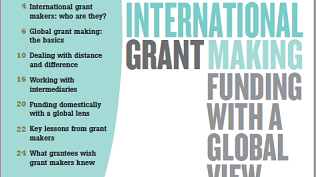International Grantmaking: Funding with a Global View

In this guide, grantmakers describe the benefits and challenges of bringing a global perspective to their work. The guide explains the regulations that govern cross-border grantmaking and shares the experiences of funders who have coped with working across geographic and cultural divides. It also weighs the merits of working through intermediaries and funding directly outside the United States.
Highlights
- Why grantmakers fund internationally
- Dealing with distance and cultural difference
- Understanding the role of intermediaries
- Bringing a global “lens” to your work at home
What’s in the Guide?
- Why Fund Internationally? What goals, values, and experiences lead grantmakers to the international arena? This section explores some of the reasons why funders bring global issues and concerns into their grantmaking.
- International Grantmakers: Who Are They? Why do different grantmakers – from private, independent foundations to individual donors – decide to get involved in funding globally?
- Global Grantmaking: The Basics: For American funders, making grants outside the United States can have complicated legal and financial implications. How can a funder learn about the options? Where can you find the latest information on relevant federal guidelines and regulations?
- Dealing with Distance and Difference: By definition, international grantees are far away, separated from funders by many miles and, often, several time zones. How do experienced grantmakers maintain a sense of connection? How do they coordinate their reporting and other systems to be clear and helpful? How do they bridge cultural and communication gaps that separate them from grantees located in other countries?
- Working with Intermediaries: Choosing an Intermediary offer a mix of supports – including local knowledge of funding needs, language skills, cultural sensitivity, and legal and financial mechanisms – that can help funders work effectively across national borders. This section describes some types of intermediaries, how they function, and the assistance they’ve provided some grantmakers.
- Funding Domestically with a Global Lens: Taking a global perspective doesn’t necessarily mean funding outside the United States. American grantmakers are increasingly applying techniques and aspirations from the global stage in their local and national funding.
